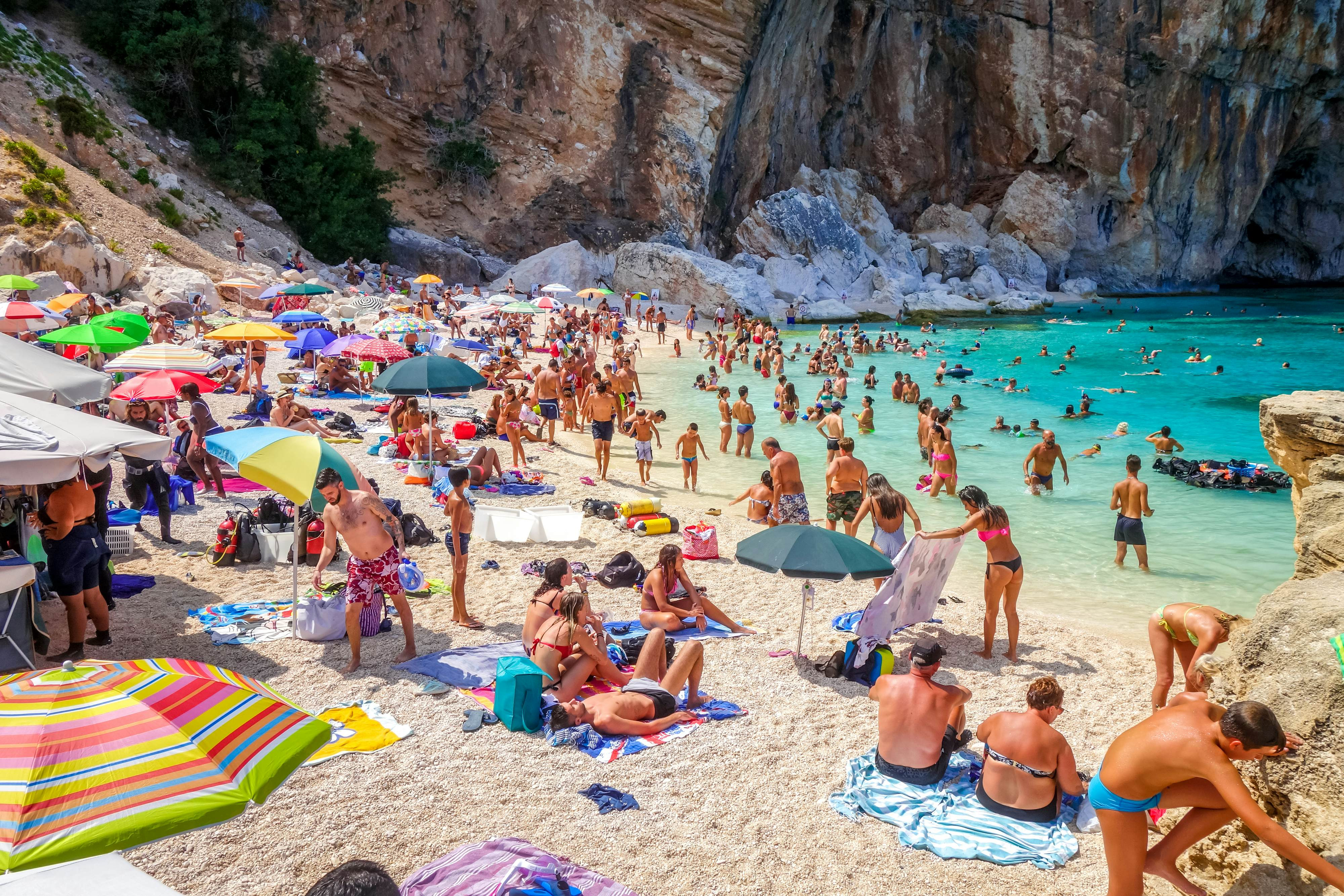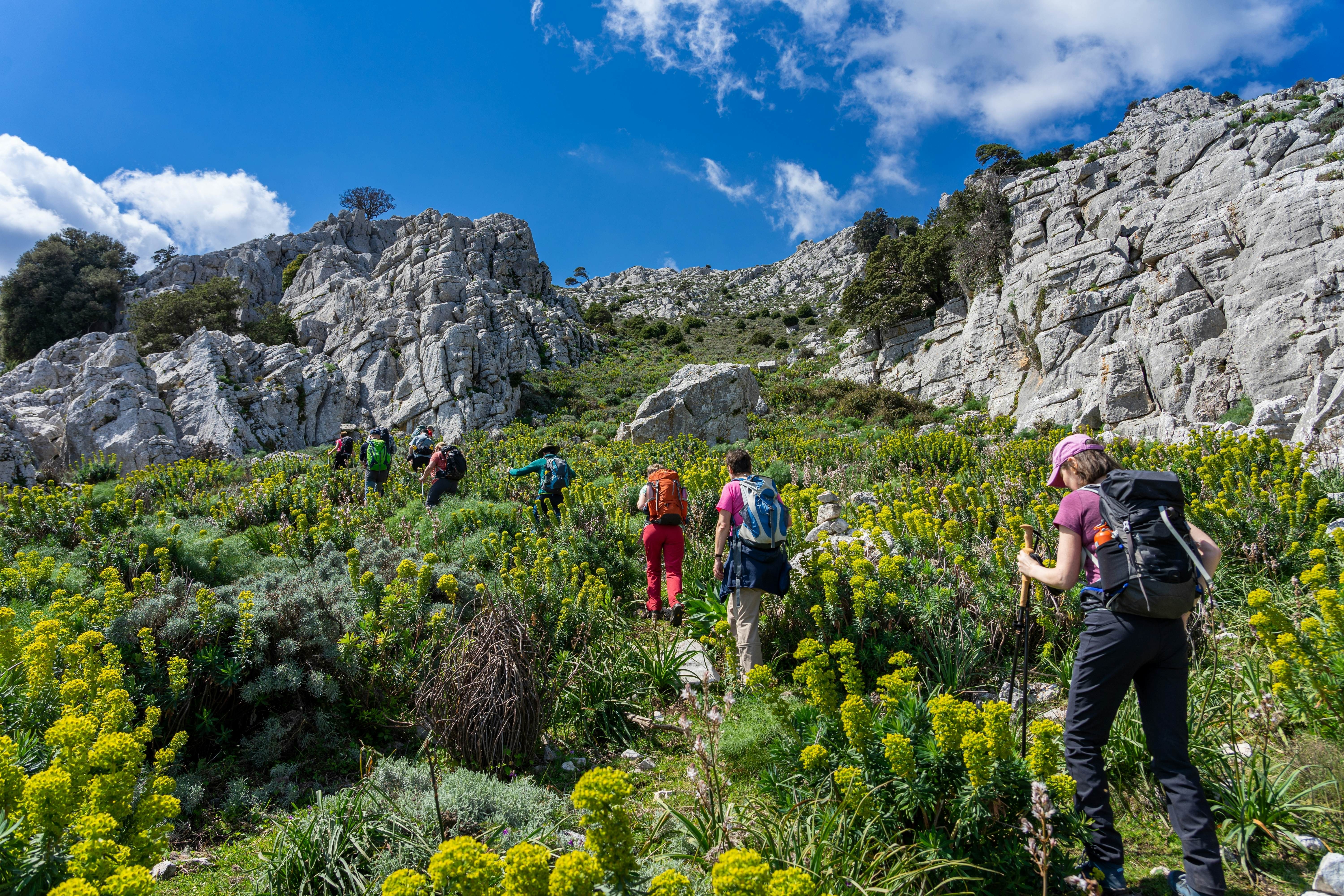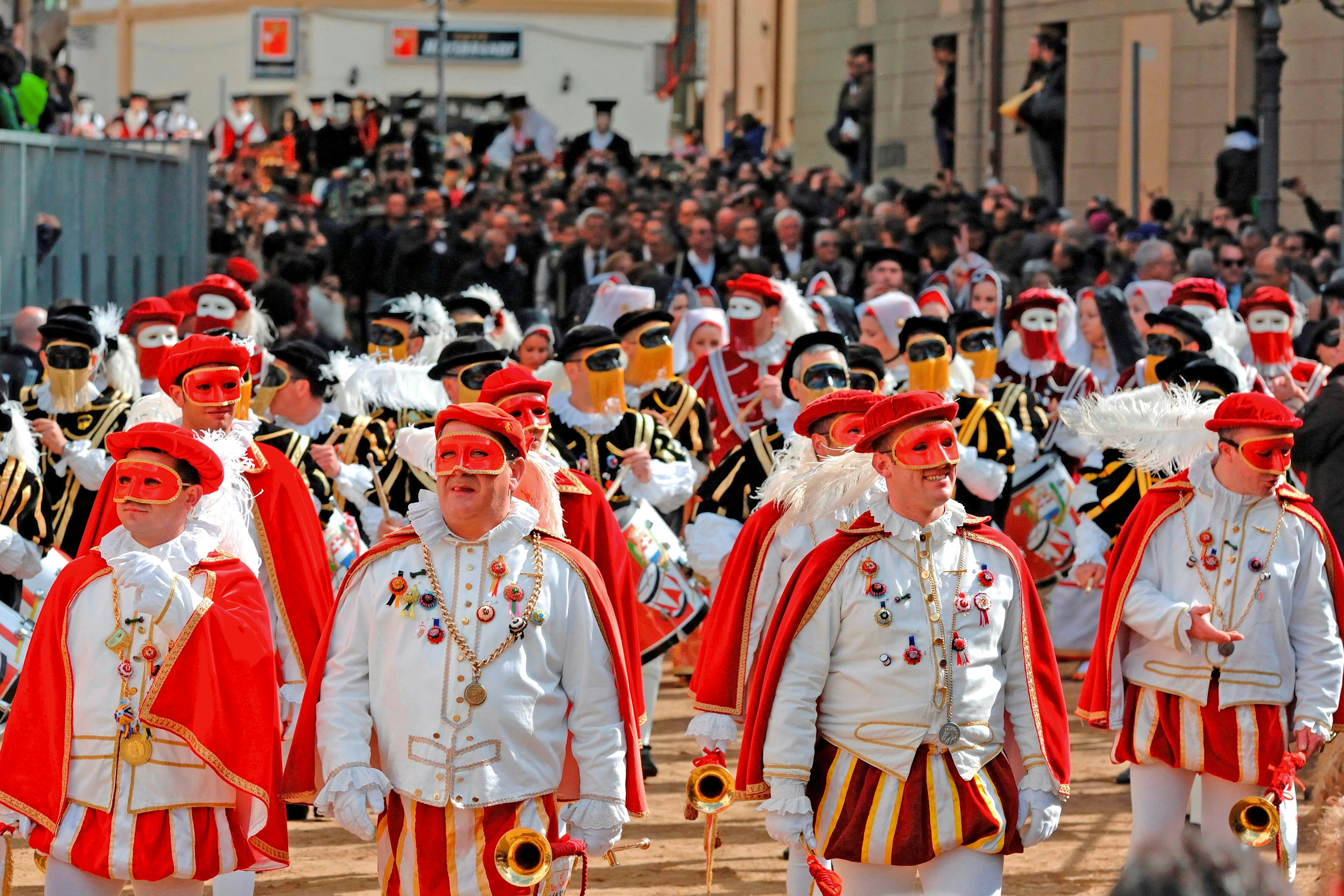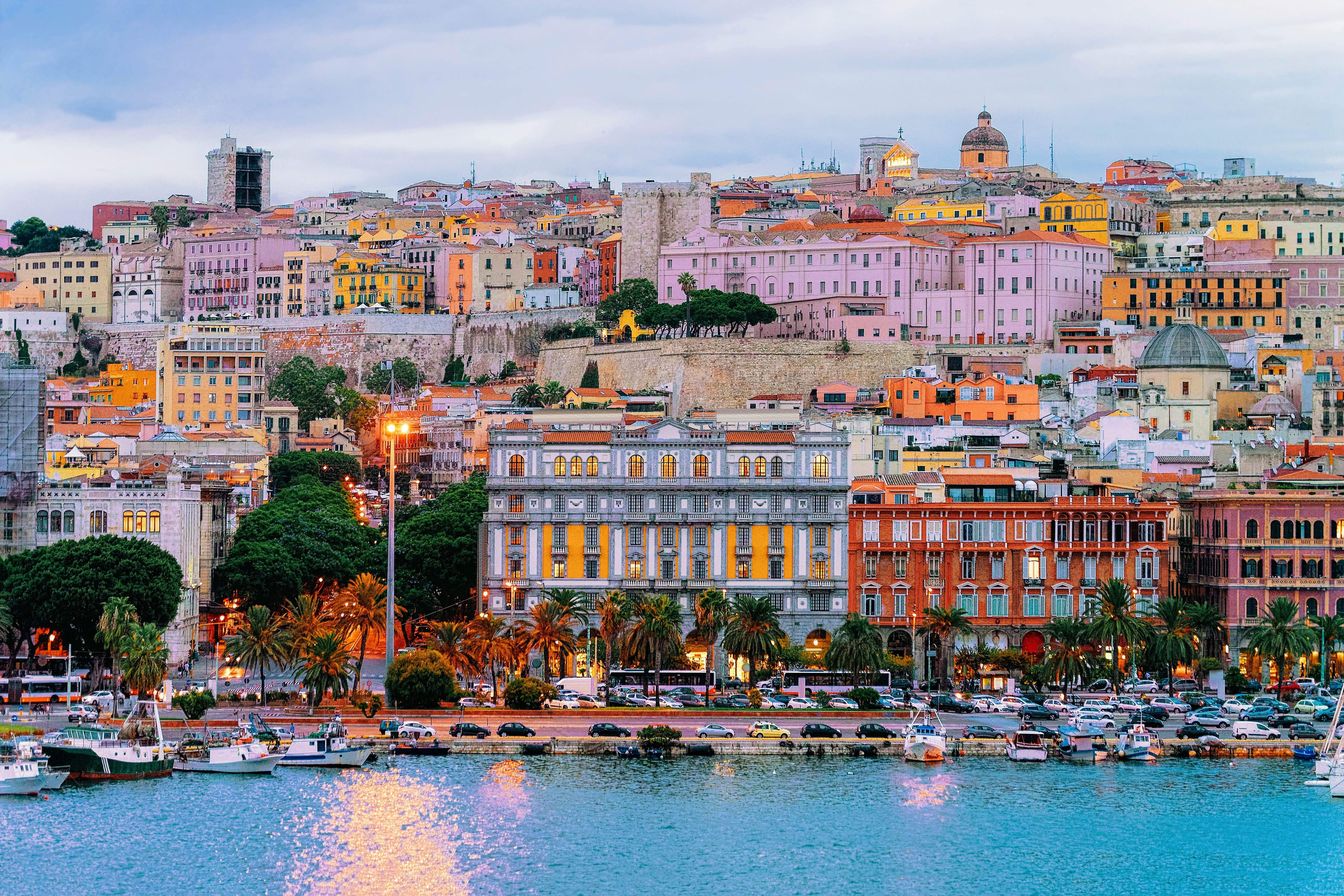Planning a trip to the mesmerizing island of Sardinia? The Best Time To Travel To Sardinia depends largely on your priorities and interests. SIXT.VN is here to guide you through the seasons, helping you decide when to visit this Italian gem for the ultimate travel experience. Whether you are looking for beach holidays, outdoor adventures or cultural immersion, the best time to visit Sardinia is right around the corner.
1. Sardinia’s Beach Season: June to September
Sardinia’s stunning beaches are at their best from June to September.
During this period, you can anticipate pleasant temperatures of 25–35°C (77–95°F), pleasant evenings, and sea temperatures ranging from 20° to 26°C (68° to 79°F). Beaches, boat excursions, and water sports are all at their height during the summer months.
However, these perfect conditions come with a disadvantage: large crowds. In July and August, tourists flock to the island, driving up prices, crowding beaches, and causing traffic congestion along the coast. It is especially advisable to avoid the busiest time around Ferragosto (August 15), when flights and lodging are extremely expensive.
 People in swimsuits crowd on a beach, many with sun umbrellas. Dozens of people swim in the shallow blue waters, and a tall cliff is visible in the distance.
People in swimsuits crowd on a beach, many with sun umbrellas. Dozens of people swim in the shallow blue waters, and a tall cliff is visible in the distance.
1.1. Avoiding the Crowds: June and September
If you want to enjoy Sardinia’s beautiful coastline and ideal weather without the summer crowds, visit in June or September. The skies are still clear, the water is still warm, and you will have much less competition for your own place in the sun.
2. Optimal Times for Outdoor Adventures: Spring and Autumn
The best seasons for outdoor activities are spring and fall, which also provide excellent value.
Mid-April to early June is a lovely time to explore Sardinia’s spectacular hiking trails in places like the Supramonte, Golfo di Orosei, and the Iglesiente Coast, thanks to moderate temperatures and spring wildflowers. From September to early October is another great time to go hiking, as the weather remains warmer and the summer crowds thin out.
Surfers will find the best conditions from March to May and September to November, while wind-sports enthusiasts can plan their visits to take advantage of the island’s two main winds: the cooler, northwesterly Maestrale (Mistral) and the warm, southeasterly Scirocco. Surfing is most popular in October.
According to research from the Italian Meteorological Society, in 2022, the shoulder seasons (April-May and September-October) offer a balanced climate for outdoor activities, with average temperatures between 18°C and 24°C and lower rainfall than winter months.
Off-season visitors can find discounts on flights, ferry tickets, and hotel rooms, with prices sometimes 50% lower than in the summer.
 A group of hikers with poles and backpacks follows a trail through blossoming yellow wildflowers, toward a karst escarpment.
A group of hikers with poles and backpacks follows a trail through blossoming yellow wildflowers, toward a karst escarpment.
2.1. Popular Hiking Spots in Sardinia
- Supramonte: Known for its challenging trails and stunning views.
- Golfo di Orosei: Offers coastal hikes with breathtaking scenery.
- Iglesiente Coast: Features diverse landscapes and historical mining sites.
2.2. Best Months for Surfing and Wind Sports
- Surfing: March to May, September to November
- Wind Sports: Dependent on the Maestrale and Scirocco winds; October is a popular month.
3. Cultural Festivities: January to April
The best time to experience Sardinia’s most vibrant festivals is from January to April.
Sardinia is rich in both Christian and pagan traditions, and many of the island’s most distinctive cultural events take place during the off-season, between January and April. Visiting the island during these months offers a more personal glimpse into Sardinian culture, as well as unforgettable travel experiences.
On January 17, the streets of Mamoiada come alive for the Festa di Sant’Antonio Abate. The town’s legendary mamuthones – men clad in hand-carved black masks and shaggy sheepskins – parade through town and dance around bonfires in the village center, with dozens of copper cowbells clanging rhythmically on their backs. The red-and-white-clad issohadores lead them, lassoing female spectators. This mysterious tradition is thought to have originated in pre-Christian ceremonies aimed at promoting fertility, warding off evil spirits, and celebrating the return of sunlight following the winter solstice. Other mountain towns, such as Ottana, Nuoro, Orotelli, and Orani, host similar winter festivals with ancient roots.
 Costumed, masked ”mamuthones,” men clad in hand-carved black masks and shaggy sheepskins, Mamoiada, Sardinia, Italy.
Costumed, masked ”mamuthones,” men clad in hand-carved black masks and shaggy sheepskins, Mamoiada, Sardinia, Italy.
3.1. Carnevale Celebrations
In February or March, equestrian escapades take center stage in Oristano during Sa Sartiglia, Sardinia’s most memorable Carnevale celebration. On the Sunday and Tuesday before Lent, crowds throng the city center to watch masked riders on horseback galloping through the sand-strewn streets, creating human towers atop their steeds and lifting their swords to pierce a star hung in mid-air – a modern-day throwback to medieval times. Bosa, Tempio Pausania, San Gavino Monreale, and Nuoro also host noteworthy Carnevale celebrations.
 Marchers in masks and costumes on parade at the Sa Sartiglia festival, Oristano, Sardinia, Italy
Marchers in masks and costumes on parade at the Sa Sartiglia festival, Oristano, Sardinia, Italy
3.2. Settimana Santa (Holy Week)
In late March or early April, the days leading up to Easter are marked island-wide by Settimana Santa (Holy Week) processions. Some of the best festivities can be found in Alghero, with its strong Catalan cultural influences; and Iglesias, where white-robed, hooded celebrants carry statues of Jesus and the Virgin Mary through the streets, accompanied by the din of drums and matraccas (a distinctively Sardinian instrument that emits a loud rattling sound).
3.3. Key Cultural Events in Sardinia
| Event | Location | Time | Description |
|---|---|---|---|
| Festa di Sant’Antonio Abate | Mamoiada | January 17 | Celebrates fertility and drives away evil spirits with masked Mamuthones dancing around bonfires. |
| Sa Sartiglia | Oristano | February/March | Features masked riders on horseback performing stunts. |
| Settimana Santa | Alghero, Iglesias | Late March/Early April | Holy Week processions with white-robed celebrants carrying statues and accompanied by traditional instruments like the matracca. |
4. Urban Exploration in Winter
Winter is the wettest season, and many businesses close down, except in the cities.
Most precipitation in Sardinia occurs between November and April, with the heaviest rainfall typically in December and January. During the rainy season, many hotels, restaurants, and bars in Sardinia’s coastal resorts are closed. However, businesses, particularly in larger cities, maintain normal hours, making winter an excellent season for exploring urban attractions such as the archaeological museums of Cagliari and Sassari.
According to data from the Regional Tourism Board of Sardinia, city hotels in Cagliari and Sassari maintain an average occupancy rate of 60% during winter months, compared to coastal resorts that see a significant drop in occupancy.
Even during the wet season, you can expect occasional dry spells. Note that the island’s mountainous interior is more prone to rainfall, while areas along the southern coast such as Capo Carbonara and Capo Sperone consistently remain the driest.
 A view from the water of the colorful facades of buildings rising on a hill in a city. Boats are visible in the marina, and a road leads along the waterfront.
A view from the water of the colorful facades of buildings rising on a hill in a city. Boats are visible in the marina, and a road leads along the waterfront.
4.1. Key Urban Attractions
- Cagliari: Known for its National Archaeological Museum and historic city center.
- Sassari: Features the Sanna National Museum, showcasing Sardinian artifacts.
4.2. Drier Areas in Winter
- Capo Carbonara: Located on the southern coast, known for its drier climate.
- Capo Sperone: Another dry spot on the southern coast, ideal for winter visits.
5. Monthly Breakdown: What to Expect
Here’s a month-by-month guide to help you decide when is the best time to visit Sardinia:
5.1. January
- Weather: Cool and rainy, averaging 8-14°C (46-57°F).
- Events: Festa di Sant’Antonio Abate in Mamoiada.
- Activities: Urban exploration in Cagliari and Sassari.
5.2. February
- Weather: Similar to January, with occasional sunny days.
- Events: Carnevale celebrations, especially Sa Sartiglia in Oristano.
- Activities: Cultural events and city tours.
5.3. March
- Weather: Mild, with temperatures rising to 10-16°C (50-61°F).
- Events: Carnevale celebrations continue.
- Activities: Early hiking and surfing.
5.4. April
- Weather: Pleasant, with blooming wildflowers and average temperatures of 13-19°C (55-66°F).
- Events: Settimana Santa processions.
- Activities: Hiking and outdoor activities.
5.5. May
- Weather: Warm and sunny, averaging 16-23°C (61-73°F).
- Events: Various local festivals.
- Activities: Hiking, surfing, and early beach visits.
5.6. June
- Weather: Hot and sunny, with average temperatures of 20-28°C (68-82°F).
- Events: Start of the summer festival season.
- Activities: Beach holidays and water sports.
5.7. July
- Weather: Hot and dry, with average temperatures of 24-32°C (75-90°F).
- Events: Numerous summer festivals.
- Activities: Beach holidays, boat tours, and water sports.
5.8. August
- Weather: Hottest month, with temperatures often exceeding 30°C (86°F).
- Events: Ferragosto (August 15) celebrations.
- Activities: Beach holidays, but expect large crowds and high prices.
5.9. September
- Weather: Warm and sunny, with average temperatures of 22-29°C (72-84°F).
- Events: End of summer festivals.
- Activities: Beach holidays with fewer crowds, hiking, and surfing.
5.10. October
- Weather: Mild, with temperatures ranging from 18-24°C (64-75°F).
- Events: Local food festivals.
- Activities: Hiking, surfing, and wind sports.
5.11. November
- Weather: Cool and rainy, averaging 12-18°C (54-64°F).
- Events: Fewer events.
- Activities: Indoor activities and exploring cities.
5.12. December
- Weather: Coldest month, with average temperatures of 8-14°C (46-57°F).
- Events: Christmas markets and celebrations.
- Activities: Urban exploration and enjoying local cuisine.
6. Sardinia Travel Tips: Make the Most of Your Trip
To make the most of your trip to Sardinia, here are some helpful tips:
- Book in Advance: During peak season (June-August), book accommodations, flights, and tours well in advance to secure the best prices and availability.
- Rent a Car: Sardinia is a large island, and renting a car is the best way to explore its diverse landscapes and hidden gems.
- Learn Basic Italian: While many people in tourist areas speak English, knowing some basic Italian phrases will enhance your experience and be appreciated by locals.
- Pack Appropriately: Depending on the season, pack light clothing, swimwear, sunscreen, and a hat for summer visits. For spring and fall, bring layers and comfortable hiking shoes. For winter, pack warm clothing and rain gear.
- Respect Local Customs: Sardinia has a rich cultural heritage, so be mindful of local customs and traditions. Dress modestly when visiting churches and religious sites.
- Try Local Cuisine: Sample traditional Sardinian dishes such as culurgiones (stuffed pasta), malloreddus (Sardinian gnocchi), and porceddu (roasted piglet).
- Stay Connected: Purchase a local SIM card or portable Wi-Fi device to stay connected, especially when exploring remote areas.
- Check Local Events: Before your trip, check local event listings for festivals, concerts, and other cultural activities that may be happening during your visit.
7. Sardinia’s Climate and Weather Patterns
Understanding Sardinia’s climate and weather patterns can greatly assist in planning your trip. The island has a Mediterranean climate characterized by hot, dry summers and mild, wet winters. Here’s a detailed look at what you can expect throughout the year:
7.1. Summer (June to August)
- Temperature: Average temperatures range from 24°C to 32°C (75°F to 90°F), with occasional peaks above 35°C (95°F).
- Rainfall: Very little to no rainfall.
- Sunshine: Abundant sunshine, with clear skies almost every day.
- Sea Temperature: Warm sea temperatures, ideal for swimming and water sports.
- Humidity: Relatively low humidity, making the heat more bearable.
- Wind: Gentle sea breezes help to moderate the heat.
7.2. Autumn (September to November)
- Temperature: Temperatures gradually decrease from the high 20s°C (low 80s°F) in September to the mid-teens°C (60s°F) in November.
- Rainfall: Rainfall increases, especially in October and November.
- Sunshine: Fewer sunny days compared to summer, but still plenty of pleasant weather.
- Sea Temperature: The sea remains warm enough for swimming in September and early October.
- Wind: Increased wind activity, with the arrival of the Maestrale (Mistral) wind.
7.3. Winter (December to February)
- Temperature: Average temperatures range from 8°C to 14°C (46°F to 57°F).
- Rainfall: Highest rainfall of the year, with frequent showers and occasional storms.
- Sunshine: Limited sunshine, with many cloudy days.
- Sea Temperature: Cold sea temperatures, not suitable for swimming.
- Wind: Strong winds, including the Maestrale and Scirocco.
7.4. Spring (March to May)
- Temperature: Temperatures gradually increase from the low teens°C (50s°F) in March to the low 20s°C (70s°F) in May.
- Rainfall: Rainfall decreases, with more sunny days.
- Sunshine: Increasing sunshine, with clear skies becoming more frequent.
- Sea Temperature: Sea temperatures begin to rise, but still cool for swimming in early spring.
- Wind: Moderate winds, with a mix of the Maestrale and Scirocco.
8. Key Considerations for Choosing Your Travel Time
To decide on the best time to visit Sardinia, consider the following:
- Budget: Prices for flights and accommodations are highest during the peak summer months (June-August). Visiting during the shoulder seasons (April-May and September-October) can save you money.
- Interests: If you’re interested in beach holidays and water sports, summer is the best time to visit. For hiking and outdoor activities, spring and autumn are ideal. For cultural events, plan your trip between January and April.
- Crowds: If you prefer to avoid crowds, avoid visiting in July and August. The shoulder seasons offer a good balance of pleasant weather and fewer tourists.
- Regional Variations: Sardinia is a diverse island, and weather conditions can vary from region to region. The mountainous interior tends to be cooler and wetter than the coastal areas.
9. How SIXT.VN Can Enhance Your Sardinia Experience
Planning a trip to Sardinia can be overwhelming, but SIXT.VN is here to make your travel experience seamless and enjoyable.
- Personalized Travel Plans: SIXT.VN offers customized travel plans that cater to your specific interests and schedule, ensuring you make the most of your time in Sardinia.
- Convenient Airport Transfers: Start your trip stress-free with SIXT.VN’s reliable airport transfer services, providing a smooth and comfortable ride to your accommodation.
- Diverse Hotel Options: Choose from a wide range of hotels that suit your budget and preferences, with SIXT.VN offering accommodations in prime locations across Sardinia.
- Exclusive Tours: Discover Sardinia’s hidden gems with SIXT.VN’s expertly guided tours, providing unique insights into the island’s culture and history.
- Best Flight Deals: Secure the best flight deals with SIXT.VN’s comprehensive flight booking service, ensuring you get the most value for your money.
Struggling to plan your Sardinia getaway? Let SIXT.VN handle the details. From airport pickups to cozy hotels and captivating tours, we’ve got it all covered. Get in touch via WhatsApp at +84 986 244 358 or visit SIXT.VN for exclusive travel packages.
Address: 260 Cau Giay, Hanoi, Vietnam. Hotline/Whatsapp: +84 986 244 358. Website: SIXT.VN.
10. Frequently Asked Questions (FAQs) About Visiting Sardinia
1. What is the best time to visit Sardinia for beach holidays?
The best time for beach holidays in Sardinia is from June to September, with warm temperatures and inviting sea conditions.
2. When should I visit Sardinia to avoid crowds?
To avoid crowds, visit Sardinia in June or September, when the weather is still pleasant but the tourist influx is lower.
3. What are the best months for hiking in Sardinia?
The best months for hiking in Sardinia are April, May, September, and October, offering moderate temperatures and beautiful scenery.
4. When can I experience Sardinia’s cultural festivals?
You can experience Sardinia’s cultural festivals between January and April, including Festa di Sant’Antonio Abate and Sa Sartiglia.
5. What is the weather like in Sardinia during the winter months?
The weather in Sardinia during the winter months (December to February) is cool and rainy, with average temperatures between 8°C and 14°C (46°F to 57°F).
6. Is it worth visiting Sardinia in the winter?
Yes, it can be worth visiting Sardinia in the winter, especially if you’re interested in exploring urban attractions and experiencing the island’s cities without the crowds.
7. What should I pack for a trip to Sardinia?
What you pack depends on the season. Pack light clothing, swimwear, and sunscreen for summer visits. For spring and fall, bring layers and comfortable hiking shoes. For winter, pack warm clothing and rain gear.
8. How can SIXT.VN help me plan my trip to Sardinia?
SIXT.VN offers personalized travel plans, airport transfers, diverse hotel options, exclusive tours, and the best flight deals to enhance your Sardinia experience.
9. What are some must-try foods in Sardinia?
Some must-try foods in Sardinia include culurgiones (stuffed pasta), malloreddus (Sardinian gnocchi), and porceddu (roasted piglet).
10. Is it easy to get around Sardinia without a car?
While public transportation is available, renting a car is the best way to explore Sardinia’s diverse landscapes and hidden gems.



